How United States Army Installations in South Korea are Tackling COVID-19
Anjeong Rodeo Street, a small downtown area located directly outside of the K6 Gate on Camp Humphreys, South Korea. The area, often referred to by service members as ‘The Ville’ has an abundance of small shops, restaurants, and pubs catering to US soldiers and their families. (Photo Credit: Google Images)
October 22, 2020
USAG Humphreys, the largest overseas military installation, located in Gyeonggi-do South Korea, has recently changed their health standard on COVID-19 limitations to ‘BRAVO’- asserting service members and families to be on moderate alert.
Limitations were changed to BRAVO after being on level CHARLIE for the past nine months; meaning that service members were barred from any travel in the country, restricted from accessing any and all bars, pubs, and nightlife. For a short time in August, though limitations were still classified under CHARLIE, service members were opened up to travel in Seoul and the surrounding areas- leading to a outbreak in cases on the installation.
The USAG’s policy on COVID-19 focuses mainly on travel of service members and their families. Though limitations are currently at BRAVO, soldiers are only allowed to travel to other military installations in Korea; however, that travel must be declared mission essential by the military chain of command. Seoul and Incheon are considered red zones due to the early concentration of COVID cases and are therefore off-limits to service members.
When asked about how they felt about the travel restrictions, an anonymous source associated with USAG Humphreys responded, “I think restricting travel in Korea is useless. We are still able to go off-post, eat in restaurants, have social gatherings, and tour certain areas. Regardless of what areas are restricted, we will still come into contact with people who have been in those ‘red-zones’. I understand why we are under limited travel restrictions, Seoul is a hotspot, but so is Pyeongtaek. So many people move through here that it is hard to track.”
Further protocol by the USAG to contain COVID-19 in and around base includes, not allowing any soldiers, service members, or civilians to enter military facilities without a mask. Groups on and off base must be no larger than 12 people, and groups of people must follow strict social distancing guidelines.
The Pyeongtaek City Government has also recently implemented several different policies regarding COVID-19; one of which cites that individuals must be wearing a mask at all times, unless eating or drinking, similar to policy in other areas of Korea. These restrictions apply to service members and foreigners living in Pyeongtaek City as well, and if not followed, can result in fines of up to 100,000KRW.
For service members, further restrictions include COVID tests every two months. Newly incoming soldiers are required to quarantine for 14 days post their arrival in country and take a COVID test within a month of being stationed at Camp Humphreys.
On the topic of the COVID testing performed by the US Military, an anonymous source reported, “I think it’s great that the military provides us with the opportunity to get tested. Seeing how my family and friends are struggling to even get tests in the States, it does feel lucky to some degree that we’re being taken care of.”
USAG Humphreys and other bases in Korea have been on lockdown since the start of the COVID-19 pandemic in early February. Currently, USAG Humphreys remains the largest overseas military base, housing over 37,000 service members, civilians, and their families.
Though for service members, being stationed in Korea was previously considered a ‘deployment,’ duty stations in Korea are becoming more and more common for young soldiers- many of them being sent to USAG Humphreys directly after their basic training.
For those hoping to learn more about the early experiences of service members during the COVID-19 outbreak in South Korea, refer to COVID-19 ON USAG HUMPHREYS.

